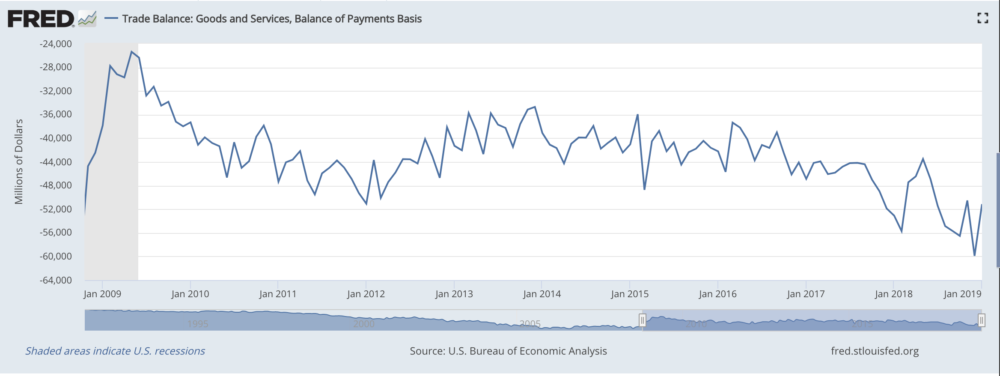A narrowing trade deficit could be a sign that the effects of President Trump’s trade war might be cooling off.
The trade gap decreased from $59.9 billion in December to $51.1 billion in January. The new number is lower than many economists had predicted.
The report on Monday saw exports rise, especially in agricultural products like soybeans, which have been a target in the trade war. Imports fell as a result of slowing demand in the United States that mirrors a continuing global slowdown.
The uptick in exports and the possibility of new trade negotiations could be good news for Americans who have felt the brunt of the trade war. Still, no one can say that with certainty until a new deal is made.

“Volatility has increased given the trade war at the moment,” David Sloan, a senior economist at Continuum Economics said. “They probably will come to a deal, and the tariff situation will fade, though Trump has been unpredictable.”
American producers and exporters have been stockpiling goods, too, as a result of a decrease in demand and a reaction to the uncertainty in the future of trade agreements with major U.S. trade partners, like China.
Many economists expected the deficit to dip in January as a correction to the high increase at the end of last year. “We have been looking for a correction on exports after December,” Sloan said. “On that, we were correct.”
Bill Shipley is a former president of the Iowa Soybean Association and currently serves on the board of directors. He is also a farmer of nearly 40 years. After China all but stopped importing American soybeans due to tariffs, Shipley said his farm went from turning a profit to just breaking even.
“Normally, we make a little profit so we can continue to grow our operations or replace our equipment or build a building for livestock if we need to. You can continue on. But when margins are as tight as they are now, you cannot move ahead. You’re just treading water, hoping for a better year next year.”
Ryan Sweet, the director of real-time economics at Moody’s Analytics, said increases in imports could be positive for farmers like Shipley. “The good sign for soybean farmers is that U.S. exports for soybeans have picked up.” At the beginning of the year, China increased its American soybean imports, though the number ultimately stayed low compared to a year before.
Even if the U.S. were to increase its exports to China soon, however, it likely would not significantly bring down the deficit, due to a decrease in U.S. consumer demand that started at the end of 2018. “There has been an undeniable slowdown,” said Gregory Daco, chief U.S. economist at Oxford Economics. “It’s not entirely clear why, to be totally transparent.”
That, along to a global weakening in demand in general, will likely prevent the U.S. from a dramatic change in the deficit. “I think you could see further narrowing in February given the jump in soybean exports, but I don’t think the deficit will significantly improve,” Sweet said.
Economists are also waiting to see what kind of effect recent airline crashes might have on exports. “I think the picture with China will improve somewhat, though we have some risk since there will be reduced demand for Boeing aircrafts,” Sloan said.
That leaves farmers like Shipley without a clear picture of what the future will look like. He said that for better or worse, that is usually the nature of the job.
“We have to be optimistic. We go out there and plant a seed the size of the end of your little finger, hope for it to grow, and raise a crop from it, and hope that we’ll have something to sell. We’re eternal optimists that things will get better. If we weren’t, everybody would sell out, and that’s not an option, either. The world needs to eat.”
Caption for audio: Bill Shipley describes some of the cutbacks he has had to make due to lower demand for the soybeans he grows.

